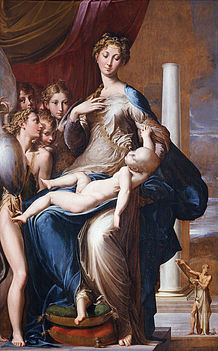|
Click here to view and print these lecture notes in PDF format. The year was 1527, and Pope Clement VII had made a big mistake. He had formed the League of Cognac, allying with France in hopes of driving Charles V, Holy Roman Emperor, out of Northern Italy. His gamble had not paid off, and the troops of the Holy Roman Empire had scaled the walls of Rome. After a decisive victory over the French, the poorly-paid imperial troops had mutinied and demanded to march on Rome, where they could be paid in plunder. And plunder they did. Once inside the city, imperial troops abandoned all discipline and killed thousands. Many of those who survived fled the city and Clement only survived thanks to a heroic stand of his Swiss Guards. Rome, formerly a city of over 50,000 inhabitants, was reduced to 10,000 residents by the time imperial troops finally had their fill and abandoned the city eight month later. The Sack of Rome taught Pope Clement a valuable lesson about the consequences of challenging the most powerful man in Europe, but a high price had been paid for his foolishness. The papacy would never regain command the glory and prestige that it once had. At the height of the Renaissance, Rome had been a center of cultural achievement. Not anymore. The year was 1527, and the High Renaissance was over. As Rome was being sacked, an artistic movement was already developing that challenged the conventions of Renaissance art with its insistence on perfect symmetry, proportion, grace, and stability. The masters of the High Renaissance had produced works that so thoroughly perfected this ideal that there was nothing left that anyone could do to rival their achievements while playing by the same rules. Even Michelangelo, the only great master of the High Renaissance who was still alive after the Sack of Rome, took his later work in a different direction. While not altogether different from the art of the High Renaissance, a new “manner” is noticeable enough in these works to give the works of the “Silver Age” of Late Renaissance art its own name. Art historians have chosen to call it Mannerism.
Michelangelo’s work had always portrayed a sense of awe and grandeur, a quality that contemporary Italian observers referred to as terribilità (terror), but the works he produced at the peak of his career balanced this with a sense of grace. His later work brought this terribilità quality to the forefront, as is seen in The Last Judgment. One does not look at this painting and think first that it is beautiful, but awe-inspiring and disturbing. Immediately, the painting was criticized for the over-muscled figures, the predominance of nudity beyond what was considered tasteful (especially for a church altar), and the incorporation of pagan themes. The suffering of the damned is portrayed with vivid emotion beyond the acceptable conventions of Renaissance art. The massive work appeared to exhaust the artist, as he chose to portray himself in the painting as the flayed St. Bartholomew. Michelangelo’s final paintings, The Conversion of Saul and The Crucifixion of St. Peter throw grace and symmetry out the window in order to fully capture vividly emotional and intense scenes from Christian history. His portrayal of Jesus in The Conversion of Saul appears in force like a modern video game character on the attack, confronting Saul with wrath in a scene of pure chaos. These final works did not gain a lot of praise at the time and rarely come up today in a discussion of Michelangelo’s work. Michelangelo is remembered first and foremost for the works he produced in his younger years as a master of the High Renaissance. As Michelangelo, in his later years, was rejecting the constraints of Renaissance conventions, younger artists were also choosing to experiment with new techniques rather than try to compete with the likes of Raphael and da Vinci. One of these younger artists, Girolamo Francesco Maria Mazzola, better known as Parmigianino (the Little One from Parma), showed an early interest in using art to portray an augmented reality. Even before the Sack of Rome, he was experimenting with new approaches. As a young man, he painted at Self-portrait in a Convex Mirror, an outside the box idea at a time when artists were obsessed with idealized realistic proportions. Parmigianino’s Conversion of St. Paul, completed over a decade before Michelangelo’s painting of the same subject, shows Paul unbalanced and in a state of fearful awe. In The Vision of St. Jerome, the central figure of John the Baptist shows a striking contrast to da Vinci’s. While da Vinci’s John the Baptist is idealized, with smooth skin and a straight finger, Parmigianino presents the Baptist as elongated, with blemishes on his skin and an elongated, crooked finger pointing to the Christ Child.  Parmigianino’s Madonna with the Long Neck is, perhaps, the most iconic Mannerist painting, presenting several challenges to traditional Renaissance conventions while not abandoning the style, altogether. The Madonna’s neck is elongated to give her a swanlike elegance, while the Christ-child, also elongated, rests precariously on her lap as if He could fall at any moment. Not only is the Christ-child imbalanced, but all of the admiring angels stand on the same side of the Madonna in a rejection of Renaissance symmetry. The Madonna’s foot is perched awkwardly on a cushion and projects outward, seemingly jutting out of the canvas. In this series of subtle challenges to the strict artistic standards of the Renaissance, Parmigianino and other Mannerist painters established themselves as “the first ‘modern’ artists” in the words of E.H. Gombrich, author of The Story of Art. Late Mannerism is most apparent in the paintings of Doménikos Theotokópoulos, better known as El Greco (the Greek). El Greco was born on Crete and distinguished himself as a painter in Western Europe, first in Rome and then in Spain, where he produced his best-known works. Like Parmigianino, he preferred elongated figures, as can be seen in his painting of St. Andrew and St. Francis, but his works show even more independence from the traditional Renaissance style. His painting of Laocoön, with its elongated and vulnerable figures fearfully succumbing to snakes sent by the gods, contrasts powerfully with a Greco-Roman sculpture of the same event, which features more powerful and idealized forms. El Greco’s most famous painting, The Burial of the Count of Orgaz, provides something of a foreshadowing of the Baroque style, projecting the grandeur of the Catholic Faith in his portrayal of the legendary account of the Count of Orgaz being buried personally by St. Stephen and St. Augustine. Unlike Michelangelo’s Last Judgment, the painting is faithful to Catholic doctrine and is devoid of pagan elements. The painting also shows Byzantine influences that were present in El Greco’s works, showing both a heavenly and earthly plane, similar to traditional Byzantine icons of the Dormition of the Mother of God. El Greco’s works are widely praised for their originality as being ahead of their time. His later works, such as View of Toledo and The Opening of the Fifth Seal, could easily be mistaken for twentieth century art by a casual observer. His work is believed to have had a powerful influence on several modern artists. The Mannerists, in their willingness to challenge prevailing artistic conventions, will forever live as examples to anyone seeking to produce something new and original. Mannerism is mentioned in AP European History Key Concept 1.1, which states, "Mannerist and Baroque artists employed distortion, drama, and illusion in their work. Monarchies, city-states, and the church commissioned these works as a means of promoting their own stature and power." El Greco is mentioned as an illustrative example, but students may use examples from Michelangelo, Parmigianino, and other Mannerist painters when presenting original evidence for free response items.
0 Comments
Your comment will be posted after it is approved.
Leave a Reply. |
Tom RicheyI teach history and government Archives
May 2023
Categories
All
|



 RSS Feed
RSS Feed